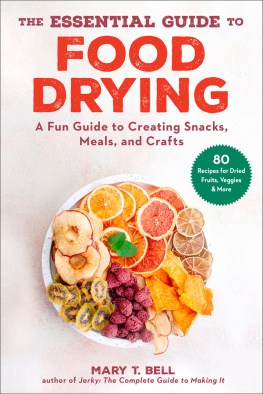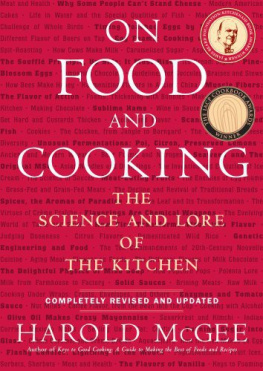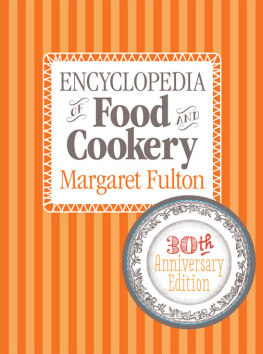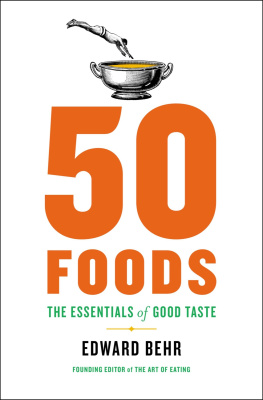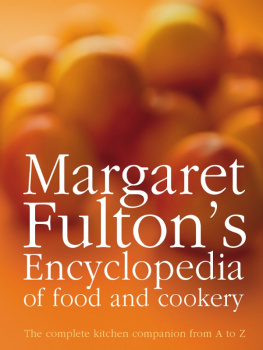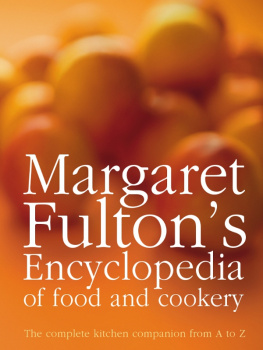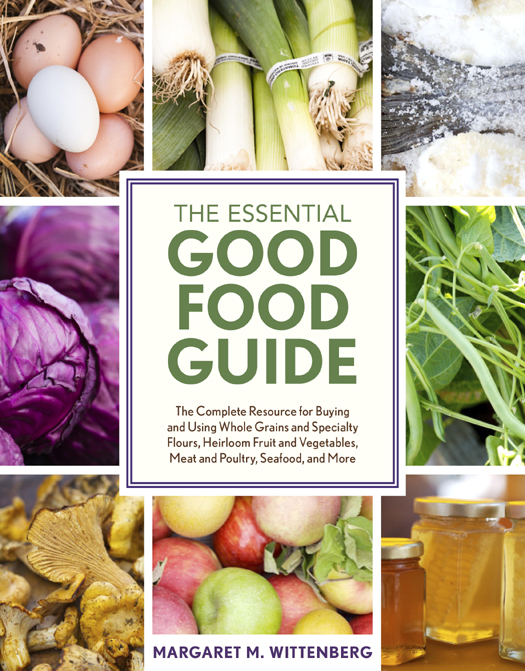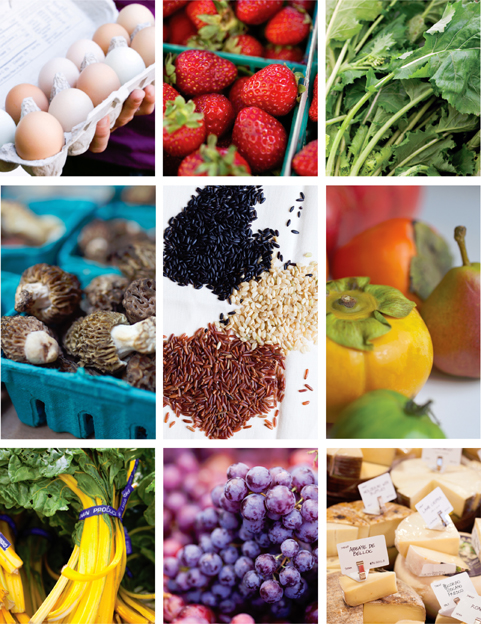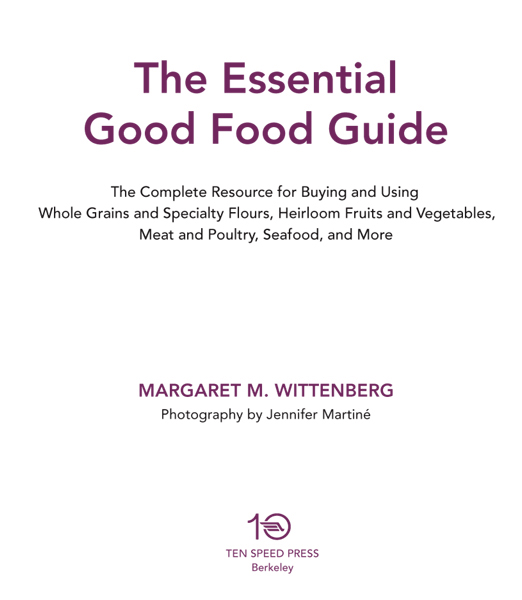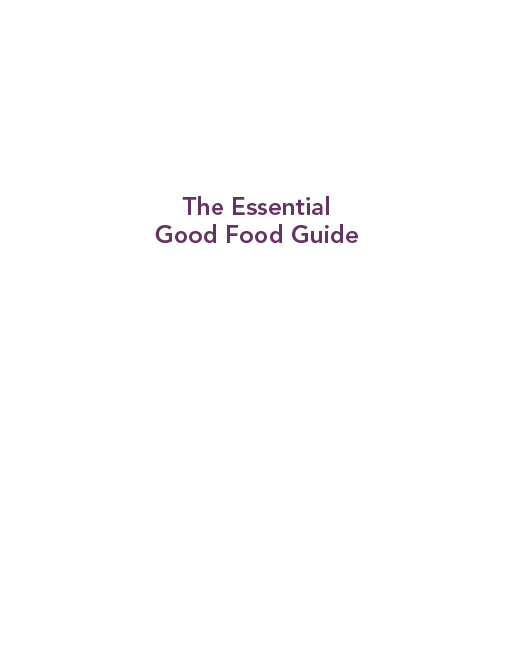Copyright 1995, 2007, 2013 by Margaret M. Wittenberg
Photographs copyright 2013 by Jennifer Martin
All rights reserved.
Published in the United States by Ten Speed Press, an imprint of the Crown Publishing Group, a division of Random House, Inc., New York.
www.crownpublishing.com
www.tenspeed.com
Ten Speed Press and the Ten Speed Press colophon are registered trademarks of Random House, Inc.
Previous editions of this work were published as Good Food: The Complete Guide to Eating Well by The Crossing Press, Freedom, California, in 1995, and as New Good Food: Essential Ingredients for Cooking and Eating Well by Ten Speed Press, in Berkeley, California, in 2007.
Instructions for courtesy of the Carolina Gold Rice Foundation
Library of Congress Cataloging-in-Publication Data is on file with the publisher
eBook ISBN: 978-1-60774-435-1
Trade Paperback ISBN: 978-1-60774-434-4
by Kathy Weigand Photography
Cover design by Sarah Adelman
v3.1
Contents
Introduction
I am an intuitive cook. Put a variety of foods in front of me and I can visualize how they might fit together, enhancing one another in terms of flavors, textures, and presentation. Although some of my knack is likely innate, much of it I developed through experience, by cooking, observing, listening, and reading. In the process, I have learned a lot about different foods, their history, how they are grown or produced, their nutritional attributes, and the best methods for cooking them. Ive also learned a lot about how various foods affect ones overall well-being. Writing this book, then, has stirred up a lot of memories for me. Each food I describe evokes the time and place when I first tried or heard about it, and all the circumstances surrounding that experience.
Nourishing My Interests
My mothers extraordinary cooking served as a backdrop to sharing the days happenings at meals with my parents and five siblings. Sunday breakfasts were my fathers realm. Inspired by my parents talents, I tried my own hand at cooking, following recipes from my beloved Better Homes and Gardens Junior Cook Book and also improvising on my own.
My interest in cooking reached a new level when, for a 4-H Club meeting food demonstration project, I was assigned the task of highlighting the visual differences between two cakes, one made with baking powder and the other without. That a food could change so dramatically by adding or deleting just one ingredient was utterly fascinating to me, igniting what would be a lifelong enthusiasm for food science and the interactions between foods and various ingredients.
When I met my husband, Terry, in 1974, we realized immediately that we shared an interest in food. Starting with a visit to a local natural foods co-op, Terry introduced me to many new foods, as well as to familiar ones that, to me, were largely unrecognizable in their raw forms. Take dried beans, for example. Although I had eaten plenty of navy bean soup and pork and beans while growing up, that had been the extent of my bean repertoireand they were purchased precooked in cans. While I knew I had a lot to learn, the beautiful, earthy colors and various shapes of uncooked beans intrigued me, as did the many bins of whole grains, nuts, and seeds. I knew I was hooked.
Terry was also the catalyst for my fascination with the nutritional aspects of food. Because hes an avid long-distance cyclist, often logging more than ten thousand miles a year, using food as a source of functional fuel has been just as important to him as the sensual pleasure of eating. While hiking, Pilates, running, weights, and dance have also figured into the picture for one or both of us throughout the years, finding the best food choices for recovery from the long miles of cycling along with maintaining overall vitality has been the biggest challengeand greatest rewardof eating a good food diet.
Fortunately for me, my love of food turned into a career. The start of more than three decades of professional connection with food began with Sunseed Natural Foods, a small natural foods store Terry and I opened in West Bend, Wisconsin, during the fall of 1977. Along with the challenges of introducing natural foods to a small, conservative Midwestern town, we also had to learn the realities of running a business. We thrived on the experience, which also got us connected with our community. We sold beef, maple syrup, fresh eggs, and fresh vegetables from a local organic farmer. And we also enjoyed a wide variety of fresh culinary herbs and unique vegetables, like kohlrabi and Jerusalem artichokes, that we bought from organic gardeners at our small towns farmers market. From teaching cooking classes to helping customers in the aisles, for us it was all about sharing the great flavors, fun, and health benefits of cooking with natural foods. It also laid a good foundation for what was to come.
After selling our store at the end of 1980, Terry and I happened by the first Whole Foods Market in Austin, Texas, just four months after the store had opened for business. We were hired in January 1981 as two of the companys original twenty-five team members, sharing in the excitement of being part of a new concept in grocery storesa one-stop shop where all the food was natural and minimally processed. In the early years, beyond working in many different areas within the store, I taught cooking classes, developed recipes, conducted food information trainings, and wrote the companys food-focused publication. The remainder of my thirty-plus years with the company have included food product and policy research along with coordinating the companys quality standards program.
Meanwhile, in the mid-1980s, I also had a one-year part-time stint as the principal cook of the East West Macrobiotic Center in Austin, Texas, where I honed my cooking skills, learning about balancing elements within a meal and the very real effects food has on body, mind, and spirit. In addition to teaching cooking classes, my main role was to create and cook a wide variety of seasonal and ethnic-focused menus for up to fifty guests for the lunches and one hundred for the monthly Friday night dinners the East West Center offered (along with the occasional Sunday brunches). There I mastered the art of cooking greens and sea vegetables, as well as using seasonings and condiments to make dishes sizzle with flavor.
For further inspiration, in the intervening years I took as many classes as I could from many of my esteemed natural foods cooking teachers, including Annemarie Colbin, Mary Estella, Susan Jane Cheney, Meredith McCarty, Carole Goodman Price, and many others who traveled through the Austin area. One of these classes spurred my interest in whole grain sourdough baking. In 1992, I started my beloved whole wheat sourdough starter and a couple years later a rye starter; both are still going strong from weekly feedings and regular use to make amazing sourdough breads, breadsticks, and muffins.



